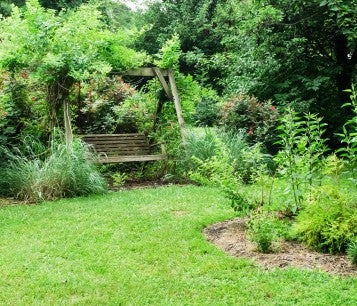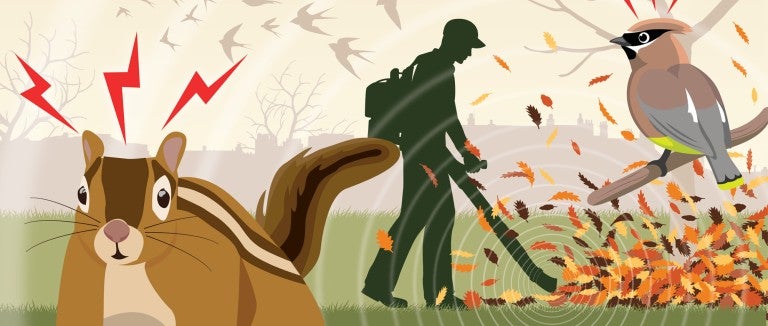Fading yellow leaves fall from tulip trees, settling as quietly as a whisper into piles of gold among the ferns. A catbird calls from a walnut branch, warning competitors away from the pokeberries. A flock of pine siskins descends to the pond, chattering softly as they sip. Young green frogs dive from lily pads—plop! plop! plop!—into the water. Though partially deaf, I can even hear the sounds of a squirrel burying his stash and a brown thrasher kicking up leaves in search of dinner.
But the soundtrack of autumn’s shifting is short-lived, grinding to an ear-splitting halt when a neighbor fires up his leaf blower and the soundscape disintegrates into chaos. The loud low-frequency noise of landscaping machinery—especially gas-powered leaf blowers—travels far, penetrating trees and homes. It’s enough to make cats dash under furniture, even after their people close the windows.
Much has been written about the effects of landscaping equipment on people and the environment. We know that gas-powered leaf blowers are not only deafeningly loud but inefficient, emitting far more pollutants than cars and trucks. We know they kick up clouds of mold, dust, pollen, feces and other contaminants in blasts of up to 200 miles per hour. And we know that this puts operators and others at risk of hearing loss, asthma, lung disease, cardiovascular disease and stress—all reasons that close to 200 municipalities across the U.S. and Canada have restricted or banned these antiquated machines. Adding insult to injury, leaf blowers drown out a proven natural benefit to our mental health: birdsong.
For wildlife, the consequences of leaf blowing are devastating: the obliteration of critical understory where many creatures forage, nest and overwinter.
How do they affect the rest of the animal kingdom, those creatures who can’t put on noise-cancelling headphones or escape indoors? For wildlife, the consequences of leaf blowing are devastating: the obliteration of critical understory where birds, frogs, fireflies, bees, caterpillars and chipmunks forage, nest and overwinter. Less considered are impacts of the noise itself. What happens when landscaping conglomerates send crews into a neighborhood with two-stroke engines strapped to their backs, imposing a sound that can be as loud as a jet plane taking flight?
As I discovered while researching my new book, Wildscape: Trilling Chipmunks, Beckoning Blooms, Salty Butterflies, and Other Sensory Wonders of Nature, early noise pollution research focuses on chronic noise, such as that of traffic. The cacophony of leaf blowers, chainsaws and riding mowers is considered acute, or episodic, confined to certain times, days or seasons. But as more people hire landscaping companies and those companies expand their hours, the lines are blurred. Mowing and blowing can span “long enough durations where it’s really disrupting what can be a critical communication time for a lot of songbirds,” says Cal Poly State University associate professor Clint Francis. “Most males are engaging in their mate attraction and territorial defense types of behaviors in the morning.”
While the effects of landscaping noise on wildlife remain unquantified, research on other episodic noises can help us make educated guesses. Snowmobiles lead to stress and escape behaviors in mammals; airplanes disrupt toad choruses and make toads easier prey; fire alarms in a lab can reduce bird activity. Even passing cars make monarch caterpillars flinch, a reaction I’ve witnessed in my own habitat. While exposing caterpillars to traffic sounds, University of Georgia research scientist Andy Davis saw it too, watching their stress levels rise so high they bit his students.
A humane backyard is a natural habitat offering wildlife plenty of food, water and cover, plus a safe place to live free from pesticides, chemicals, free-roaming pets, inhumane practices and other threats. And it's so easy to build!

In ongoing studies, noise from traffic and natural gas compressors led to reduced egg hatching in bluebirds and tree swallows; less efficient foraging by bats and owls; reduced ability of birds to hear alarm calls; delayed responses to frog mating calls; lowered presence of many insects and spiders; narrowing of birds’ vocal ranges; and higher presence of mice, who appear to use noise to hide from predators. Changes in animal behavior have cascade effects, even disrupting forest composition: When scrub jays—who disperse pinyon pine seeds in New Mexico—avoided areas near natural gas compressors, four times fewer pinyon pines grew.
Across North America, species considered common—American goldfinches, cedar waxwings, nuthatches—avoid noisy areas. Worldwide, migratory birds do the same, a potentially massive change in range. Animals occupying smaller home territories or raising young can’t even try to escape. How can we make the world safer for them in our own backyards?
Momentum toward a transition to electric equipment is unstoppable now, but it’s only a partial victory. Though quieter, those machines still blast away habitat and pollute the soundscape. We need to remember a time, not too many decades ago, when leaf blowers didn’t exist—when rakes were the tool of choice and more leaves were left under trees and shrubs, enhancing the soil and blanketing our wild neighbors.
As far as I know, no one was harmed by leaves left on the land in that pre-leaf-blower era. But many of our wild neighbors die or suffer now—or are never born in the first place—when we remove those leafy layers that serve as their only home. Leaf blowers are just one manifestation of our culture’s war on nature. But we have the power to say no to their use and yes to the voices they suppress. The birds and frogs and chipmunks have something to tell us, if we put down the power tools long enough to listen.
Want more content like this?
This was written and produced by the team behind All Animals, our award-winning magazine. Each issue is packed with inspiring stories about how we are changing the world for animals together.
Learn MoreSubscribe
